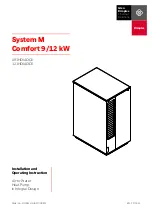
60
Technical data
CLB/EN (1901) 6.6
10.4.2
Noise level of entire pump unit
In order to determine the total noise level of the entire pump unit, the noise level of the
motor must be added to that of the pump. This can be easily done by using the graph
above.
1 Determine the noise level (L1) of the pump, see figure 25 or figure 26.
2 Determine the noise level (L2) of the motor, see documentation of the motor.
3 Determine the difference between both levels |L1 - L2|.
4 Find the differential value on the |L1 - L2|-axis and go up to the curve.
5 From the curve go left to the L[dB] -axis and read out the value.
6 Add this value to the highest value of both noise levels (L1 or L2).
Example:
1 Pump 75 dB; motor 78 dB.
2 |75-78| = 3 dB.
3 3 dB on the X-axis = 1,75 dB on the Y-axis.
4 Highest noise level + 1,75 dB = 78 + 1,75 = 79,75 dB.
Figure 27:
Noise level of entire pump unit.
4102
L [dB]
|L1 - L2| [dB]
0
1
2
3
4
5
6
7
8
9
10 11 12 13 14 15 16 17 18 19 20
3,2
3,0
2,8
2,6
2,4
2,2
2,0
1,8
1,6
1,4
1,2
1,0
0,8
0,6
0,4
0,2
0,0
Summary of Contents for SPX Flow CombiLineBloc
Page 2: ......
Page 6: ...4 INT EN 1512 1 2 ...
Page 10: ...8 CLB EN 1901 6 6 ...
Page 14: ...12 Introduction CLB EN 1901 6 6 ...
Page 26: ...24 General CLB EN 1901 6 6 ...
Page 44: ...42 Disassembly and assembly CLB EN 1901 6 6 ...
Page 50: ...48 Dimensions CLB EN 1901 6 6 ...
Page 56: ...54 Parts CLB EN 1901 6 6 ...
Page 66: ...64 ORDFORM 1512 3 3 EN ...






































